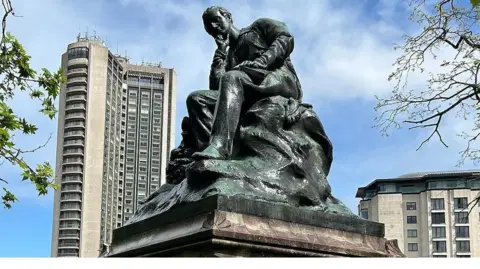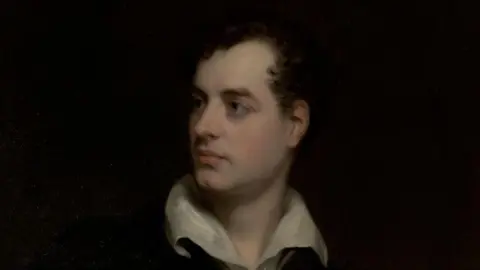Lottery funds 'rescue' of Park Lane Byron statue
 Heritage of London Trust
Heritage of London TrustA statue of famed 19th Century poet Lord Byron that has been marooned on a traffic island on Park Lane in central London for decades could be relocated.
The Byron Society was awarded more than £230,000 by the National Lottery towards the cost of moving the National Byron Memorial Statue.
The Grade II listed bronze sculpture created in 1880 became inaccessible to the public after Park Lane became a three-lane dual carriageway in the 1960s.
The Byron Society is seeking planning permission from Westminster City Council to move the statue to a space near Hyde Park's Victoria Gate.
'Immensely grateful'
If permission is granted the statue will be placed in a landscaped location already approved by the Royal Parks, which looks after the central London park.
The current Lord Byron, president of the Byron Society, said the society was "absolutely thrilled and immensely grateful" to The National Lottery Heritage Fund.
He said the lottery and its players were "helping us rescue Byron and put him back to where he can be appreciated".
The Heritage of London Trust is supporting the restoration, which it said would involve the "removal of dirt, grease, grime, detritus, and guano".
It added that the bronze would be re-patinated to match the original finish as closely as possible.
 Nottingham City Museums and Galleries
Nottingham City Museums and GalleriesThe statue was discussed in the House of Lords in April 2024 when a descendant of Lord Byron cited a government pledge made in 1958 during a debate on the then new Park Lane traffic scheme.
Lord Lytton, Byron's great-great-great-grandson, said the bronze likeness "languishes" in an isolated spot.
Lord Byron was a popular Romantic figure in Victorian Britain, described as "mad, bad and dangerous to know" by one of his lovers, Lady Caroline Lamb.
He was born in London's Holles Street, off Oxford Street, in 1788.
He died from a fever in 1824 in Missolonghi, in modern day Greece, after joining Greek insurgents the year prior to fight a war of independence against the Ottoman Empire.
Listen to the best of BBC Radio London on Sounds and follow BBC London on Facebook, X and Instagram. Send your story ideas to [email protected]
